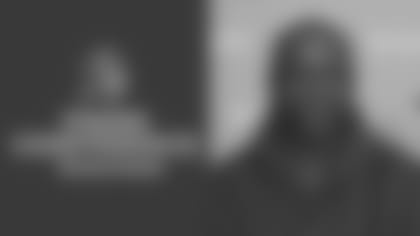Derrick Brooks says Defensive Coordinator Monte Kiffin knows the right times to put his defense into the Cover Two
?
Editor's Note: The following feature is excerpted from *Buccaneers Review, Volume 3, Issue 3. Buccaneers Review is the Tampa Bay Buccaneers' ground-breaking answer to the traditional game program. Buccaneers Review is sold at every Tampa Bay home game and it includes entirely new material, cover to cover, every issue. The magazine-style publication includes exclusive interviews with Buccaneer players and their opponents; in-depth feature stories; a close look at the opponent and their key players; cheerleader features; columns by Head Coach Jon Gruden and long-time Buc standout Dave Moore; rosters, depth charts and much more. In the last issue, Buccaneers Review tried to determine why the Cover Two defense under Monte Kiffin has had such sustained success in Tampa. In the wake of yet another dominant performance by Tampa Bay's defense on Sunday, we re-run that feature here on Buccaneers.com.*
When Monte Kiffin first pulled a late-night Xs-and-Os session in his One Buccaneer Place office, Bill Clinton and Bob Dole were addressing their respective national conventions on the TV in the background.
Gas was $1.30 a gallon. DVDs had just been introduced in Japan. The Dow Jones was on fire. Houses could be had for 50 bucks apiece, milk was still delivered to your doorstep in glass bottles and "talkies" were the new rage at the cinemas.
Okay, so maybe 1996 wasn't that long ago. After all, Mariah Carey was pumping out hits then, too, and EBay was already facilitating online swaps. But it was 12 years ago, and in the National Football League, a dozen seasons is like a lifetime, or at least several generations.
Heck, 24 of the 30 NFL head coaches in 1996 didn't even see the new millennium with the same teams (yes, we know that the millennium began in 2001.) Turnover is the norm in the NFL, and not just for head coaches. Coordinators, players, schemes…success comes and goes, and with it ride the performers and the game plans they're performing.
The reasons for change are myriad. Innovative thinkers create new offenses, and sooner or later defenses adjust. New personnel arrives that makes one scheme more viable than another. Poor seasons cost and hair-trigger decision-makers cost coaching staffs their jobs, and the new crew in town has its own way of running things. You're more likely to find a gas marquee reading $3.00 than a team that is running the same offense or defense in 2008 that it ran in 1996.
And yet, in Tampa, the Buccaneers are about to embark on their 13th straight season of confounding the rest of the league with the elegantly simple Cover Two defense. Kiffin, who has pulled enough midnight-oil sessions at two different One Buccaneer Places to be serenaded by thousands of late-night political overtures, is still the defensive coordinator. Derrick Brooks has started every single game of the Cover Two's existence in Tampa. Ronde Barber is entering his 12th year in the system and might reasonably be considered the greatest Cover Two corner ever.
How? Why is the Buccaneers' defense a steady island in the ever-swirling waters of NFL schemes and approaches? Just what is with the incredible staying power of the Tampa Two?
**
The answer, in a two-word nutshell: It's simple. The more in-depth answer: No it isn't.
How easy is the defense to install? The Buccaneers, no paragons of defense for the first half of the 1990s, were almost instantly successful in the system imported by Kiffin and then-Head Coach Tony Dungy in 1996, rising from 27th in 1995 to 11th that year and taking up near-permanent residence in the top 10 starting the next season. Some of the player personnel that would make the scheme hum over the next decade was already on hand, some wasn't, but the defense still stuck.
"It's easy to teach, easy to learn and really can be coached up simply by telling guys to hustle and hit," said Barber, the only 20-sack, 20-interception cornerback in NFL history. "That makes it easy to use, and I think a lot of the league has gone to it, at least in part, for that reason. At the end of the day it's not so much about scheme, it's about players. This Cover Two that we run, even with all the adjustments, is pretty accessible for a lot of people to learn. It makes it fun, really, because you can just go out and play."
The basic tenets of the scheme are even simple enough for the layman to grasp. Though they don't completely explain the system's nuts and bolts, here are four of its main concepts: 1) Two safeties stay deep, splitting the field in half and working to eliminate big plays; 2) The four defensive linemen are responsible for generating most of the pass rush, keeping seven players in coverage; 3) The back seven defenders keep plays in front of them whenever possible, then read and react to the quarterback and where the ball is delivered; 4) The defense's personnel must have at least a couple players who can "play in space," covering large areas of the field in a zone and making tackles by themselves. These players must get the "check-downs" while the middle linebacker covers the deep middle of the field.
That last point is significant. As Brooks points out, while trying to retain as much modesty as one could possibly expect from a 10-time Pro Bowler, a large portion of the credit for the Bucs' sustained defensive success belongs to some very specific players.
"We've been able to have players in space, myself and Ronde," said Brooks. "Between the two of us, we've got to cover from the top of the numbers on one side to the top of the numbers on the other side, 12 or 14 yards deep from the line. We play in space a lot, so you've got to have some athletes that are able to make one-on-one tackles. Read-and-react to the quarterback – you've got to be able to do that or this defense won't survive. That's the other element to add to that. You need players who can play in space and read and react to the quarterback."
As for the X-and-O basics of the system, they are indeed simple on the surface, but Kiffin and the Bucs have found more and more complex ways to employ them. The Tampa Two has a life of its own now, which is why it has gained its own nickname. The Cover Two scheme was rarely used across the NFL in 1996 but now its everywhere; the Tampa Two is the Bucs' own version, constantly tweaked for continued success.
"We've tweaked a few things and the Cover Two changes from year to year a little bit, subtle changes," said Kiffin. "It's still basically Cover Two, and then we mix some other coverages in. We don't play as much Tampa Two at any one given time as we used to. The surprise element's not there anymore because everybody in the league plays it. Offensive coaches and players see it a lot. So we mix in some other coverages. But we still do play it, no doubt about it."
This is where it's not so simple anymore. You can understand where the Bucs are starting with their two deep safeties and their four-man pass rush, but you might not grasp where they are now without living through all the changes during the past dozen years, as Kiffin, Brooks and Barber remarkably have.
"Most people don't see it because they see the big picture; they don't see the individual strokes of the brushes," said Brooks. "We do tweak our defense every year. I think that has allowed us to continue playing in the system and allowed us to be comfortable in the belief that, when we do tweak it, it's going to work.
"The changes that we make in it are sometimes so subtle that people don't realize it because we're doing it out of a disguise. So, besides the players that we have and Coach Kiff having confidence in it, the third element is that we do tweak it."
In fact, they often go away from it completely, though their opponents aren't always aware of this fact. Like every team in the league, the Buccaneers mix up their coverages and personnel packages from play to play. The team that took a simple concept like the Cover Two and made it a league-wide phenomenon often attacks opposing offenses with schemes that have nothing at all to do with a two-deep zone.
However – and this is the key – many of the plays that don't originate in a Tampa Two format look like they do before the snap. Like any team, the Bucs try to disguise what they're doing on defense so as not to give the opposing quarterback an easy read. In Tampa Bay's case, the disguise is often the same. And the fact that so much of what the Bucs' defense is doing looks the same before the snap also disguises a trend that covers the last decade; namely, the Bucs take a lot fewer snaps in the Cover Two these days than they used to.
"If you're doing it by percentage of plays we're in the Cover Two, back then I would say we were somewhere in the 60s or 70s. Last year I think we played just about 40% of it. That's a pretty significant difference over 60 plays in every football game. So we've evolved, definitely, into some other things. Two is our base, but we play a lot of different looks. The ironic thing is, we kind of want everything to look the same, so a lot of it looks like Cover Two. It's a way for us to keep teams off balance."
There's a bit of irony in the Buccaneers' gradual decline in Cover Two snaps. It is, in essence, a symptom of its own success.
When the Bucs began playing primarily two-deep zones in 1996, it was something of a novel approach. The Cover Two concept wasn't invented by Kiffin, Dungy or the Buccaneers, but it isn't a stretch to say they perfected it beyond anything that had come before. It is also obvious that the Bucs' success with the approach led to other teams incorporating it into their approach. When the Bucs ran the Cover Two in 1996, it was almost as if they were the Houston Oilers operating the run-and-shoot; opponents might only see it once a year.
"It's like when I was coaching in college at Nebraska," said Kiffin. "Oklahoma used to run the Wishbone, and they were great at it. They won national championships with it. We would play them in the 11th game of the year, the day after Thanksgiving every year. It was a tradition. For 10 games you never saw the Wishbone, then all of a sudden in five days you've got to get ready for it. It used to be that way with the Tampa Two. We played the St. Louis Rams in '99 and they had not seen it. That was the 'Greatest Show on Turf,' and they were not ready for it. Now they see it a lot. If we play them in Week Seven they might have seen it three out of the first six weeks. The quarterback knows how to read it now, and they have plays that we call 'Two-beaters.'
Kiffin's NFL example is right on the money. The Buccaneers very nearly upset the seemingly unstoppable Rams in the 1999 NFC Championship Game, holding them nearly 20 points below their season average in what proved to be an unexpected slugfest. If not for a third-down, 30-yard touchdown pass to Ricky Proehl with five minutes left in an eventual 11-6 St. Louis victory, the Cover Two might have been in the Super Bowl.
Eleven months later, the Bucs and Rams met again in Tampa, in what turned out to be one of the most exciting games in Buccaneer history. This time, the Bucs prevailed 38-35, but as the score indicates it was an offensive give-and-take. Perhaps the exception proves the rule here – the Bucs' still-stingy defense allowed 17 points or fewer to every one of its last nine opponents that year, except for the Rams – but it's also likely that the Rams had spent some time figuring out the holes in the Tampa Two.
"That Monday night game was a little quirky in a lot of ways," recalled Barber. "It ended up being a shootout, and we never get into shootouts. But, yeah, they had found some ways to beat it, and over the course of the next nine years or whatever a lot of 'Two-beaters' have shown up. And that's why we've had to evolve. There are a lot of plays that you can't cover in Two that good smart offensive coordinators figured out. It just makes it difficult on you, so you have to evolve a little bit."
Of course, that brings it back to Kiffin, the architect, the evolutionary guiding hand. You can't run the Tampa Two on every play, but you can't abandon it, either, unless you are going to abandon your underlying defensive philosophies. You have to blitz on occasion, even if that's antithetical to the Cover Two. You have to know when to be aggressive and when to be patient.
"There's a time in the game to call the Tampa Two," said Brooks, "and that's where the strategic prowess of Coach Kiff comes into play. It's picking the spots when to call it throughout the ballgame, and it's us as players knowing that we have to be on top of the details or we're going to get exposed. It's a combination of both elements."
Added Barber: "Your game plan adjusts every week because of personnel. In Pittsburgh, Dick LeBeau is great at analyzing matchups and putting players in position to make plays. Monte's the same way. For years, if you go back and look at stories and what people were saying about our defense in the late '90s it was that Monte always put us in position to make plays. That's the essence of good defense if you ask me."
The Steelers are another rare example of a lasting scheme, having excelled at the 3-4 basic front for as long as most NFL fans can remember. Pittsburgh receives very well-deserved credit for acquiring the exact sort of personnel that fits into its system. The same can be said about the Buccaneers, who know the type of defender that can perpetrate its schemes. Derrick Brooks and Ronde Barber would likely be stars on any team, but they are absolutely perfect fits for the Cover Two.
Of course, it's difficult to constantly field 11 Tampa Two studs. It may be awhile before Tampa Bay finds another Warren Sapp, and Brooks and Barber will be difficult to replace eventually. The Buccaneers must adjust their efforts to the strengths and weaknesses of their depth chart like any other squad. And that, too, has led to tweaks in the team's approach over the last dozen years. The Bucs' current defense is highlighted by what is clearly one of the best secondaries in the game.
"The structure's the same as it's always been," said Brooks. "However, we're playing a few more defenses now that are driven by the secondary, whereas some of our defenses of the past were driven by a different group. We play some coverages now because we have a different talent in our secondary, and that allows us to mix other coverages in with our Cover Two. Some of our defenses in the past were more driven by our defensive line or the linebackers. That's where the chess match comes in."
Most of the Bucs' opponents play chess by trying to isolate a king or queen on an inferior piece. Offenses across the league strategize for hours upon hours looking for ways to get their best weapons into man-to-man opportunities with lesser athletes. The Tampa Two tries to counter this approach by eliminating such opportunities and keeping the playmakers in front of the defenders. After that, it's a matter of reading the quarterback, hustling to the ball, hitting hard and being sound in your tackling technique…and having all 11 men on the field in the same mindset.
Of course, neither the Buccaneers nor the Tampa Two invented the concept of hustling or form tackling. Such simple concepts can't possibly explain the sustained success of one system in a league that is constantly cycling through schemes, coordinators and players. Given all that Kiffin and Barber and Brooks have had to say about the Tampa Two to this point, what is it, really, that gives the defense its staying power?
"Because it's sound," summarized Barber. "Every defense has strengths and weaknesses, and there are a lot more strengths in Cover Two than there are weaknesses. Everything stays in front of you. Assuming it's played correctly, you eliminate big plays from the equation. You keep everything in front of you, and like I said, you teach guys to hustle and hunt and make tackles. If it's done right, it makes for a very successful defense."
























